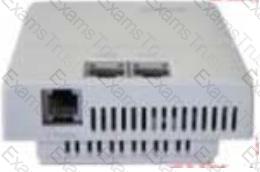Which of the following is the correct description of the steps for working with the WLAN Tester 2.0 tool?
Which AP is shown in the figure below?

Xiao Zhang is the network administrator of a hotel. One day he found that the hotel's visitors could not access the network normally. After checking, the visitor's equipment was wrong.
Incorrect IP address, in order to prevent this kind of attack, which of the following technologies should be used in the network?
In the WLAN coverage, the accuracy of wireless positioning is closely related to AP signal coverage.
Which of the following wireless applications has higher bandwidth and real-time requirements?
What is the correct statement about the site survey of the indoor coverage scene coverage area?
The following is a preliminary description of the preliminary planning before the survey?
In the coverage area, only the area where the field strength is required is selected (B), and the area with the specified number of bandwidth requirements is selected (A), and there is no concern whether there is a signal. Area selection?
The following description of the steps for Layer 2 roaming is wrong?
The user traffic of an enterprise WLAN is not very large, and there is no traffic bottleneck in the network. For WLAN security, the customer wants to manage it in a unified manner.
For WLAN data, which of the following networking methods can customers choose?
What is the default priority of VRRP?
In the ACU2 solution of an independent AC board of a WLAN campus network project, the switch where the board is located and the ACU2 board are logically two independent networks.
Yuan, that is, an independent management device.
How many mw can 17dBm be converted into?
As shown in the figure below, what is the best channel for the AP in the lower left corner?

After the CAPWAP is disconnected, the AP allows the new user access function to support the following authentication methods?
Directional antennas have a stronger gain in signal strength in horizontal and vertical lobes, and no signal outside the lobes. So it is recommended to use high gain
Directional antennas to increase outdoor AP coverage distance.
In an Mesh network, is the AP connected to the AC through a wire called?
What are the advantages of Mesh deployment compared to WDS deployment?
How many dB of directional antenna attenuation is the main lobe width of the phenomenon?
Which of the following two tools are needed to measure the attenuation value of an obstacle?
The following is the correct description of the AC deployment method?
When using the WLAN Tester 2.0 tool, the dot speed is preferably controlled from 0.8m/s to 1.2m/s. What is the correct statement about the dot speed?
In an outdoor wireless coverage scenario of a WLAN, the AP6510DN is used to cover the external antenna, and the throughput of the wireless terminal is maintained at a low value.
What are the reasons for the results?
When WLAN design outdoor network regulations, it is necessary to consider the coverage according to the EIRP limit of each country. In the case of considering MIMO gain, the following
Which option is the calculation method for EIRP?
Which of the following PoE powering solutions can power the AP?
In some special environments, more APs need to be used, and the channels cannot be completely separated. Therefore, you can consider reducing the transmit power of the AP to reduce the letter.
Interference between the numbers.
Which of the following authentication methods requires the user to open a web page for authentication?
In the direct forwarding mode of the bypass network, what are the descriptions of the following WLAN HA technologies?
The following is true about the WLAN side-by-side networking.
Which of the following options are typical WLAN indoor-mounted coverage scenarios?
What are the calculations for implementing controller hot backup?
Which of the following functions is not a function of Huawei WLAN Planning Tool?
In the 3-hop co-frequency chain Mesh, assuming that the throughput of the MPP is 60 Mbps and the throughput under each MP is the same, the throughput of each MP is
How many?
What is the correct description of PoE power supply below?
The wireless forwarding capabilities of the following devices range from low to high. What is the correct ordering?
Which of the following tools can an engineer use when planning a WLAN network?
Which of the following statements about directional antennas and omnidirectional antennas is correct?
Which of the following outdoor APs supports dual 5G deployment scenarios?
Which of the following authentication methods has the longest roaming time?
The directional antenna can not only improve the signal strength of the downlink AP, but also improve the signal strength of the uplink terminal received by the AP.
Without considering the MIMO gain, what is the correct description about EIRP?
In the backhaul scenario where the AP6510DN is connected to the AT815SN in point-to-point, the return distance is about 100m. The six AT815SNs are distributed in a length of 60 meters and wide.
Within 60 meters, the equipment is installed at the same height and has a line of sight.
When the upstream bandwidth requires 10 Mbps and there is no EIRP limit, which of the following antennas can be selected?